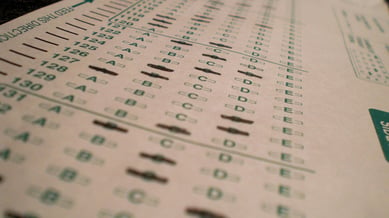
Last month I wrote a post on how I initially teach my students to look at multiple choice problems. If you have not read it, I would recommend doing that first before reading on.
As I wrote, I initially give my students two dimensions on which to assess an answer choice: truth and relevance. I start with these two for a few reasons. Firstly, whether or not a student can tell me if an answer choice is true generally correlates with their level of knowledge and to some extent the quality of their knowledge or content studying. Additionally, I ask students to assess the relevance of the answer choice to ensure that the students are always going back to the question with each answer choice. This prevents a common misstep: choosing an answer choice that is factually correct, but does not answer the question. These dimensions are helpful but do not encompass all of the dimensions in which answer choices may differ. However, there are myriad ways in which answer choices might differ, and as such it stops being efficient to memorize dimensions and assess them one at a time. This is what I call a direct approach, and while useful, there is a better way.
The comparative approach
Simply put, I teach my students to compare 2 answer choices and ask themselves how the answer choices are different. Often answers are different in multiple dimensions beyond just truth or relevance and can be differently characterized in terms of tone, underlying premise, temporal reference, certainty etc. Simply by trying to observe the differences, often a dimension comes to mind upon which a student can, with total justification (link below), eliminate an answer choice. (For example, a factually correct answer in the CARS section might be inconsistent in tone with the passage in general.)
I start by comparing the first two answer choices: A &B. I look at how each choice is different, figure out which difference is relevant to the problem, decide which anserchoice is worse and rule it out. Why do I decide which one is worse as opposed to which is better? As you can read about in this post, it’s important to avoid biases. If I decide that one answer choice is better, I could start to conflate a better answer with being the right answer, and then anchor on that, not giving othe other answers a real analysis. There is little risk of this if I go the other way and rule answers out for being worse. Worst comes to worst, I rule out all the answer choices, realize I have made a mistake and try again. Anyways, once I have ruled an answer choice (let’s say B), I move on to compare A and C, ruling one of them out. Then I compare the to survivors (say A and D), and rule out whichever is worse. I mark the last answer standing as correct and move on.
While this tactic is most useful in CARS, it can be applied to all sections of the MCAT(or for that matter the SAT, LSAT or any other multiple choice test).
What tactic to use?
Do I recommend always using the comparative approach? No. I don’t recommend always using either the direct or comparative approaches. For that matter, I also wrote a post about simplifying complex answer choices. There are many tactics and which one to use depends on the question and the answer choices. Students need to build judgment on what tactic to use and when, which comes from doing many problems, and from working with a skilled tutor that can exemplify good judgment. However, no matter what, I always recommend students use Total Justification , continue to be aware of the many Biases that could push them in the wrong direction, and conduct diligent post-game analysis of every answer.
Are you interested in connecting with a standardized test preparation coach in Boston or New York?
Want to read more written by Henry? Check out some of his previous blog posts below!

Comments